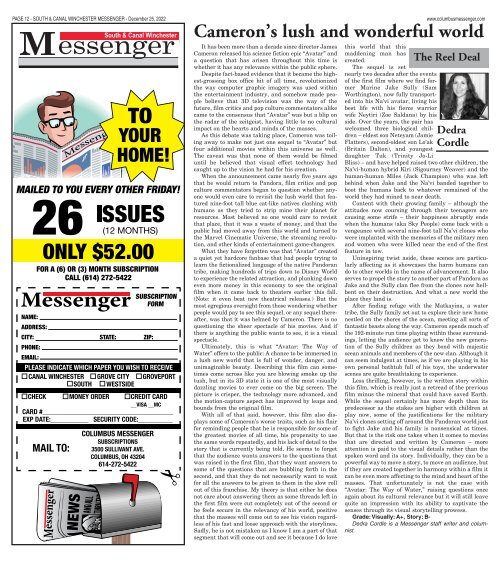South & Canal Winchester Messenger - December 25th, 2022
You also want an ePaper? Increase the reach of your titles
YUMPU automatically turns print PDFs into web optimized ePapers that Google loves.
PAGE 12 - SOUTH & CANAL WINCHESTER MESSENGER - <strong>December</strong> 25, <strong>2022</strong><br />
<strong>Messenger</strong><br />
<strong>South</strong> & <strong>Canal</strong> <strong>Winchester</strong><br />
www.columbusmessenger.com<br />
Cameron’s lush and wonderful world<br />
It has been more than a decade since director James<br />
Cameron released his science fiction epic “Avatar” and<br />
a question that has arisen throughout this time is<br />
whether it has any relevance within the public sphere.<br />
Despite fact-based evidence that it became the highest-grossing<br />
box office hit of all time, revolutionized<br />
the way computer graphic imagery was used within<br />
the entertainment industry, and somehow made people<br />
believe that 3D television was the way of the<br />
future, film critics and pop culture commentators alike<br />
came to the consensus that “Avatar” was but a blip on<br />
the radar of the zeitgeist, having little to no cultural<br />
impact on the hearts and minds of the masses.<br />
As this debate was taking place, Cameron was toiling<br />
away to make not just one sequel to “Avatar” but<br />
four additional movies within this universe as well.<br />
The caveat was that none of them would be filmed<br />
until he believed that visual effect technology had<br />
caught up to the vision he had for his creation.<br />
When the announcement came nearly five years ago<br />
that he would return to Pandora, film critics and pop<br />
culture commentators began to question whether anyone<br />
would even care to revisit the lush world that featured<br />
nine-foot tall blue cat-like natives clashing with<br />
humans as they tried to strip mine their planet for<br />
resources. Most believed no one would care to revisit<br />
that place, that it was a waste of money, and that the<br />
public had moved away from this world and turned to<br />
the Marvel Cinematic Universe, the streaming revolution,<br />
and other kinds of entertainment game-changers.<br />
What they have forgotten was that “Avatar” created<br />
a quiet yet hardcore fanbase that had people trying to<br />
learn the fictionalized language of the native Pandoran<br />
tribe, making hundreds of trips down to Disney World<br />
to experience the related attraction, and plunking down<br />
even more money in this economy to see the original<br />
film when it came back to theaters earlier this fall.<br />
(Note: it even beat new theatrical releases.) But the<br />
most egregious oversight from those wondering whether<br />
people would pay to see this sequel, or any sequel thereafter,<br />
was that it was helmed by Cameron. There is no<br />
questioning the sheer spectacle of his movies. And if<br />
there is anything the public wants to see, it is a visual<br />
spectacle.<br />
Ultimately, this is what “Avatar: The Way of<br />
Water” offers to the public: A chance to be immersed in<br />
a lush new world that is full of wonder, danger, and<br />
unimaginable beauty. Describing this film can sometimes<br />
come across like you are blowing smoke up the<br />
tush, but in its 3D state it is one of the most visually<br />
dazzling movies to ever come on the big screen. The<br />
picture is crisper, the technology more advanced, and<br />
the motion-capture aspect has improved by leaps and<br />
bounds from the original film.<br />
With all of that said, however, this film also displays<br />
some of Cameron’s worse traits, such as his flair<br />
for reminding people that he is responsible for some of<br />
the greatest movies of all time, his propensity to use<br />
the same words repeatedly, and his lack of detail to the<br />
story that is currently being told. He seems to forget<br />
that the audience wants answers to the questions that<br />
was raised in the first film, that they want answers to<br />
some of the questions that are bubbling forth in the<br />
second, and that they do not necessarily want to wait<br />
for all the answers to be given to them in the slow roll<br />
out of this franchise. My theory is that either he does<br />
not care about answering them as some threads left in<br />
the first film were cut completely out of the second or<br />
he feels secure in the relevancy of his world, positive<br />
that the masses will come out to see his vision regardless<br />
of his fast and loose approach with the storylines.<br />
Sadly, he is not mistaken as I know I am a part of that<br />
segment that will come out and see it because I do love<br />
this world that this<br />
maddening man has<br />
created.<br />
The sequel is set<br />
nearly two decades after the events<br />
of the first film where we find former<br />
Marine Jake Sully (Sam<br />
Worthington), now fully transported<br />
into his Na’vi avatar, living his<br />
best life with his fierce warrior<br />
wife Neytiri (Zoe Saldana) by his<br />
side. Over the years, the pair has<br />
welcomed three biological children<br />
— eldest son Neteyam (Jamie<br />
Flatters), second-oldest son Lo’ak<br />
(Britain Dalton), and youngest<br />
daughter Tuk (Trinity Jo-Li<br />
The Reel Deal<br />
Dedra<br />
Cordle<br />
Bliss) — and have helped raised two other children, the<br />
Na’vi-human hybrid Kiri (Sigourney Weaver) and the<br />
human-human Miles (Jack Champion) who was left<br />
behind when Jake and the Na’vi banded together to<br />
boot the humans back to whatever remained of the<br />
world they had mined to near death.<br />
Content with their growing family — although the<br />
attitudes now coursing through their teenagers are<br />
causing some strife — their happiness abruptly ends<br />
when the humans (aka Sky People) come back with a<br />
vengeance with several nine-foot tall Na’vi clones who<br />
were implanted with the memories of the military men<br />
and women who were killed near the end of the first<br />
feature in tow.<br />
Uninspiring twist aside, these scenes are particularly<br />
affecting as it showcases the harm humans can<br />
do to other worlds in the name of advancement. It also<br />
serves to propel the story to another part of Pandora as<br />
Jake and the Sully clan flee from the clones now hellbent<br />
on their destruction. And what a new world the<br />
place they land is.<br />
After finding refuge with the Matkayina, a water<br />
tribe, the Sully family set out to explore their new home<br />
nestled on the shores of the ocean, meeting all sorts of<br />
fantastic beasts along the way. Cameron spends much of<br />
the 192-minute run time playing within these surroundings,<br />
letting the audience get to know the new generation<br />
of the Sully children as they bond with majestic<br />
ocean animals and members of the new clan. Although it<br />
can seem indulgent at times, as if we are playing in his<br />
own personal bathtub full of his toys, the underwater<br />
scenes are quite breathtaking to experience.<br />
Less thrilling, however, is the written story within<br />
this film, which is really just a retread of the previous<br />
film minus the mineral that could have saved Earth.<br />
While the sequel certainly has more depth than its<br />
predecessor as the stakes are higher with children at<br />
play now, some of the justifications for the military<br />
Na’vi clones setting off around the Pandoran world just<br />
to fight Jake and his family is nonsensical at times.<br />
But that is the risk one takes when it comes to movies<br />
that are directed and written by Cameron — more<br />
attention is paid to the visual details rather than the<br />
spoken word and its story. Individually, they can be a<br />
powerful way to move a story, to move an audience, but<br />
if they are created together in harmony within a film it<br />
can be even more affecting to the mind and heart of the<br />
masses. That unfortunately is not the case with<br />
“Avatar: The Way of Water,” raising questions once<br />
again about its cultural relevance but it will still leave<br />
quite an impression with its ability to captivate the<br />
senses through its visual storytelling prowess.<br />
Grade: Visually: A+, Story: B-<br />
Dedra Cordle is a <strong>Messenger</strong> staff writer and columnist.


















